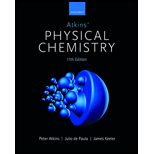
Concept explainers
(a)
Interpretation:
The wavefunction,
Concept introduction:
When an operator operates on a function and gives back the function along with a constant, then the function is known as eigen function of the operator and the constant is known as eigen value. A general eigenvalue equation is represented as shown below.
(a)
Answer to Problem 7F.8P
The wavefunction,
Explanation of Solution
The wavefunction given is as follows.
Apply
The above equation shows that wavefunction,
(b)
Interpretation:
The wavefunctions
Concept introduction:
Same as mentioned in part (a).
(b)
Answer to Problem 7F.8P
The wavefunctions,
Explanation of Solution
The wavefunctions given are as follows.
In order to show a wavefunction real, the product of that wavefunction with its conjugate is estimated as shown below.
The value of
Substitute
Therefore,
The product of wavefunction
Substitute
Therefore,
(c)
Interpretation:
The wavefunctions
Concept introduction:
For the orthogonality of the wavefunctions, one of the wavefunction is integrated with the conjugate of the other wavefunction over the entire limits. It is expressed by the equation as given below.
(c)
Answer to Problem 7F.8P
The wavefunctions
Explanation of Solution
In order to show orthogonality, the product wavefunction,
Substitute
Therefore, the wavefunctions
(d)
Interpretation:
The normalization of
Concept introduction:
For the normalization of the wavefunction, the wavefunction is integrated as a product of its conjugate over the entire limits. It is expressed by the equation as given below.
(d)
Answer to Problem 7F.8P
The normalization of
Explanation of Solution
In order to show normalization, the product wavefunction,
Substitute
Therefore,
The product of wavefunction
Substitute
Therefore,
(e)
Interpretation:
The angular nodes of the wavefunctions
Concept introduction:
Same as mentioned in part (a).
(e)
Answer to Problem 7F.8P
The angular nodes in the wavefunctions
Explanation of Solution
The angular node is equal to the value of
Therefore, the numbers of angular nodes present in the wavefunctions
The plane to which the angular nodes of wavefunctions
(f)
Interpretation:
Whether the wavefunctions
Concept introduction:
Same as mentioned in part (a).
(f)
Answer to Problem 7F.8P
The wavefunction
Explanation of Solution
The value of operator
Apply
Since on applying
This means the value of
Want to see more full solutions like this?
Chapter 7 Solutions
Atkins' Physical Chemistry
 ChemistryChemistryISBN:9781305957404Author:Steven S. Zumdahl, Susan A. Zumdahl, Donald J. DeCostePublisher:Cengage Learning
ChemistryChemistryISBN:9781305957404Author:Steven S. Zumdahl, Susan A. Zumdahl, Donald J. DeCostePublisher:Cengage Learning ChemistryChemistryISBN:9781259911156Author:Raymond Chang Dr., Jason Overby ProfessorPublisher:McGraw-Hill Education
ChemistryChemistryISBN:9781259911156Author:Raymond Chang Dr., Jason Overby ProfessorPublisher:McGraw-Hill Education Principles of Instrumental AnalysisChemistryISBN:9781305577213Author:Douglas A. Skoog, F. James Holler, Stanley R. CrouchPublisher:Cengage Learning
Principles of Instrumental AnalysisChemistryISBN:9781305577213Author:Douglas A. Skoog, F. James Holler, Stanley R. CrouchPublisher:Cengage Learning Organic ChemistryChemistryISBN:9780078021558Author:Janice Gorzynski Smith Dr.Publisher:McGraw-Hill Education
Organic ChemistryChemistryISBN:9780078021558Author:Janice Gorzynski Smith Dr.Publisher:McGraw-Hill Education Chemistry: Principles and ReactionsChemistryISBN:9781305079373Author:William L. Masterton, Cecile N. HurleyPublisher:Cengage Learning
Chemistry: Principles and ReactionsChemistryISBN:9781305079373Author:William L. Masterton, Cecile N. HurleyPublisher:Cengage Learning Elementary Principles of Chemical Processes, Bind...ChemistryISBN:9781118431221Author:Richard M. Felder, Ronald W. Rousseau, Lisa G. BullardPublisher:WILEY
Elementary Principles of Chemical Processes, Bind...ChemistryISBN:9781118431221Author:Richard M. Felder, Ronald W. Rousseau, Lisa G. BullardPublisher:WILEY





